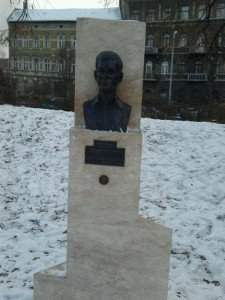People who set themselves on fire for Hungarians

Committing somebody to the flames was a common sentence in several historic eras. But it turned into something more. Setting oneself on fire became a form of resistance, protesting against an idea. It started with a Czech university student whose act influenced Hungarian students as well as others. Index.hu presented the story of two young boys.
Sándor Bauer
On the 20th of January, 1969 a 17-year-old boy, Sándor Bauer poured gasoline all over his body and set himself on fire in the garden of the National Museum. He started running while in flames, but collapsed after a few metres. He was still conscious in the hospital but 85% of his body got burnt. He died three days later, but before that he was taken into custody by the authorities with a justification that “he said outrageous things about the Soviet troops stationed in Hungary, the Hungarian Socialist Workers’ Party and the Hungarian Revolutionary Worker-Country Government in the company of his friends.”
He didn’t act in the heat of the moment. He applied to the forestry vocational school in Szeged, but, despite his good results they chose the son of a party secretary instead of him. He decided to become a car mechanic with the encouragement of his father who worked in a party garage. The house he lived in was fired to ground by the Soviet occupation troops in 1956. These things affected his view of the world and at an older age he held club meetings in his cellar where he constantly enounced his oppositionist views.
Jan Palach, a Czech university student, had a big effect on him with his act of resistance by setting himself on fire on the main square of the capital of Czechoslovakia, thus expressing his protest against the Soviet entry in 1968.
 According to index.hu, Bauer even left a goodbye-letter behind in which he declared himself a Leninist but made it clear that he protested against the Soviet occupation.
According to index.hu, Bauer even left a goodbye-letter behind in which he declared himself a Leninist but made it clear that he protested against the Soviet occupation.
“I greet everyone in the class. Every teacher and every student. I’m sending you my message, that, without an idea one does exist, but does not live. Fight, as I recommended to. I’m setting myself on fire just like the Czechoslovakian student did on the 19th. Thus protesting against the Soviet occupation. Don’t hate the Russian nation, it is not the Russian proletariat that enslaves us. It is the Russian national Bolshevism. This is not what Comrade Lenin forethought.
With communist regards, Sándor
P.s.: Give my greetings to Tankos and Udvarias Pajti! Watch out, the Russian leaders and the capitalists of the USA divided the world! Don’t expect any good from the USA.
For my parents: Dear Mom and Dad! Forgive me if I hadn’t been a good son to you. I want to live, but now, the Nation and the proletariat need my burnt body. I send kisses to my dear granny and beloved uncles, nephews and nieces.”
Naturally, the party press concealed the story and only reported about a boy who tried to commit suicide. Even though Bauer died from his injuries the case wasn’t closed up. Two of his friends, Miklós Sajbán and István Berger, were interrogated for months.
Sándor had an exact concept of a Soviet-free future: his thoughts resemble Kossuth’s ideas. He believed that the smaller socialist countries like Hungary, Poland, Czechoslovakia and Romania should form the “league of the Danube countries”.
Zsolt Balogh directed a document drama of Sándor Bauer’s act with the title 1968. Also, you can visit his memorial tablet in the garden of the National Museum or his statue at Mátyás Square in the 8th district.
Márton Moyses
His story isn’t as widely known as Sándor Bauer’s, but there was a young boy in Transylvania too who protested against communism by setting himself on fire. He tried to get across the Hungarian border with three of his companions during the revolution of 1956, but they got lost. He was arrested in 1960 for his poems “Revolution tomorrow”, “Red and black reaction” and “Conversation with death” and sentenced for 7 years of prison. He tried to escape from making a confession by cutting his own tongue with a piece of tread, but the men of Securitate, the Romanian secret service, stitched it back without anaesthesia.
Index.hu writes that Moyses suffered from depression and blaze of anger, probably due to the cruel interrogations. His case was reconsidered and lightened on account of his condition, but in reality he served the whole of his sentence.
He couldn’t continue his university studies. He lived a modest life for a few years working at a collective farm. He wanted to take part in the scientific world, but his imprisonment meant disfranchisement, moreover he had to face rejection whenever he applied somewhere.
One year after Jan Palach’s and Sándor Bauer’s death-fire, on the 13th of February, 1970, Márton Moyses went to the hall of the communist party in Brasov, poured gasoline all over his body and set himself on fire. He died three months later under custody, in the hospital of Barót. At the command of the Securitate he did not get medical attendance, all of his poems and most of his photos were eliminated. A memorial tablet can be visited at his onetime home in Nagyajta since 2005.
Photo: www.facebook.com/pages/Mátyás-tér
Copy editor: bm
Source: http://index.hu/





